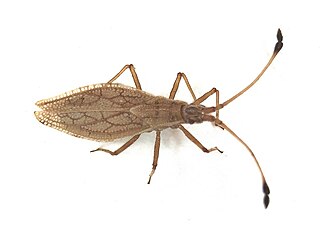
Copium is a genus of lace bugs in the family Tingidae.
Hesperotingis is a genus of lace bugs in the family Tingidae. There are about eight described species in Hesperotingis.
Abdastartus is a genus of lace bugs in the family Tingidae. There are about five described species in Abdastartus.
Bunia is a genus of lace bugs in the family Tingidae. There are about six described species in Bunia.

Kalama is a genus of lace bugs in the family Tingidae. There are at least 30 described species in Kalama.
Sinuessa is a genus of lace bugs in the family Tingidae. There are about eight described species in Sinuessa.

Tingis is a genus of lace bugs in the family Tingidae. There are at least 130 described species in Tingis.

Melanorhopala is a genus of lace bugs in the family Tingidae. There are about five described species in Melanorhopala.
Leptodictya is a genus of lace bugs in the family Tingidae. There are at least 60 described species in Leptodictya.
Leptopharsa is a genus of lace bugs in the family Tingidae. There are more than 120 described species in Leptopharsa.

Galeatus is a genus of lace bugs in the family Tingidae. There are about 18 described species in Galeatus.
Acanthocheila is a genus of lace bugs in the family Tingidae. There are about 17 described species in Acanthocheila.
Vatiga is a genus of lace bugs in the family Tingidae. There are about 11 described species in Vatiga.

Minitingis is a genus of lace bugs in the family Tingidae. There are at least two described species in Minitingis.
Cantacaderinae is a subfamily of lace bugs in the family Tingidae. There are about 16 genera and at least 90 described species in Cantacaderinae.

Derephysia is a genus of lace bugs in the family Tingidae. There are more than 20 described species in Derephysia.
Pseudacysta is a genus of lace bugs in the family Tingidae. There is one described species in Pseudacysta, P. perseae, which is a pest of avocado trees.
Calotingis is a genus of lace bugs in the family Tingidae. There are at least two described species in Calotingis.
Corythaica is a genus of eggplant tingids in the family Tingidae. There are more than 20 described species in Corythaica.
Alveotingis is a genus of lace bugs in the family Tingidae. There are at least three described species in Alveotingis.






